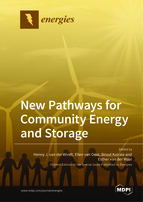New Pathways for Community Energy and Storage
A special issue of Energies (ISSN 1996-1073). This special issue belongs to the section "D: Energy Storage and Application".
Deadline for manuscript submissions: closed (30 April 2020) | Viewed by 82378
Special Issue Editors
Interests: energy transition; community energy; socio-technical systems; science-society interactions; environmetal history; responsible innovation; ecological restoration
Interests: innovation; energy; energy storage; gender, scenario srudies; technology assessment
Interests: community energy; integrated energy system; renewable energy; institutional design; responsible innovation; energy transition; energy citizenship
Special Issues, Collections and Topics in MDPI journals
Interests: community energy; socio-technological innovation; social impact assessment; value sensitive design; geography; commons
Special Issue Information
Dear Colleagues,
Our energy landscape is changing. Local communities are increasingly taking active roles and emerging as new actors in the energy system. For example, some local energy initiatives own solar panels, wind turbines and energy storage system collectively, while others build renewable energy configurations, together with other energy system actors. Community energy and energy storage may enable effective energy system integration and get maximum benefits of local generation. Energy storage is one of the key issues of the energy transition and local energy communities are important drivers behind the transformation towards a more sustainable energy system, particularly when it comes to decentralized energy systems. This may lead to more flexible and resilient energy supply systems, and therefore, can play an important role in achieving renewable energy and climate policy objectives.
New and innovative socio-technological energy storage configurations are emerging at local and regional levels. Energy storage technologies are going through a great deal of public discourse, networking and experimentation. The decreasing cost of energy storage and the increasing demand for local flexibility is opening up new possibilities for energy storage systems deployment at the local level. In this context, energy storage can help to better integrate the heat and electricity system at the local level and can positively contribute towards energy transitions while accommodating the needs and expectations of citizens and local communities. Yet, there are technological and social challenges of integrating energy storage in the largely centralized present energy system, which demands for socio-technical innovation. More attention is required in the societal dimensions of energy storage technology and the technological aspects of social innovation around energy storage technologies.
This Special Issue is being organized within the framework of the International Conference New Pathways for Community Energy and Storage organized by the Universities of Groningen and Twente on 6 and 7 of June 2019 in Groningen, the Netherlands.
This Special Issue aims to address important questions related to energy transitions and the role of community energy and storage therein. We invite submission from researchers and practitioners to provide new stimulating insights to continue efforts for promising pathways, in theory and practice, regarding technological and social aspects of energy transition.
In line with the key themes of the international conference, we accept submission on following key topics:
Transformative power of community energy
Citizens' engagement in community energy
Community energy storage and flexibility
New pathways for community energy innovation in practice
Local energy innovation
Changing roles and responsibilities
New pathways for local energy storage in practice
Responsible innovation in community energy
Community energy in Europe
Games as means for energy communication and involvement
New business models for community energy and storage
Community energy and low-carbon transition
Community energy storage: opportunities, challenges and perspectives
Developing country perspective on community energy
Aligning institutions and technology in community energy systems
Renewable energy communities, consumer (co-)ownership and energy sharing
Regulatory and institutional aspects of community energy and storage
Dr. Henny J. van der Windt
Dr. Ellen van Oost
Dr. Binod Koirala
Dr. Esther van der Waal
Guest Editors
Manuscript Submission Information
Manuscripts should be submitted online at www.mdpi.com by registering and logging in to this website. Once you are registered, click here to go to the submission form. Manuscripts can be submitted until the deadline. All submissions that pass pre-check are peer-reviewed. Accepted papers will be published continuously in the journal (as soon as accepted) and will be listed together on the special issue website. Research articles, review articles as well as short communications are invited. For planned papers, a title and short abstract (about 100 words) can be sent to the Editorial Office for announcement on this website.
Submitted manuscripts should not have been published previously, nor be under consideration for publication elsewhere (except conference proceedings papers). All manuscripts are thoroughly refereed through a single-blind peer-review process. A guide for authors and other relevant information for submission of manuscripts is available on the Instructions for Authors page. Energies is an international peer-reviewed open access semimonthly journal published by MDPI.
Please visit the Instructions for Authors page before submitting a manuscript. The Article Processing Charge (APC) for publication in this open access journal is 2600 CHF (Swiss Francs). Submitted papers should be well formatted and use good English. Authors may use MDPI's English editing service prior to publication or during author revisions.
Keywords
- Community energy
- Community energy storage
- Local energy system
- Energy transition
- Socio-technical systems
- Governance and business models








